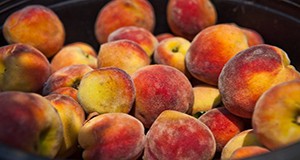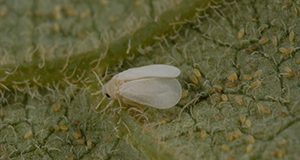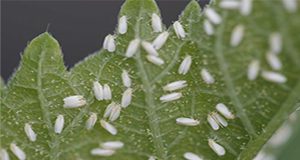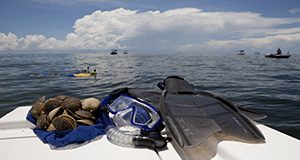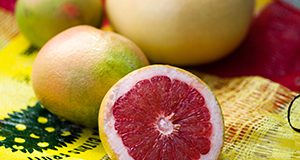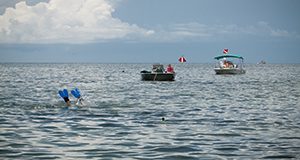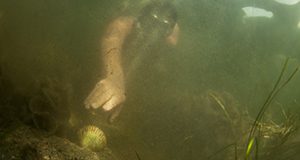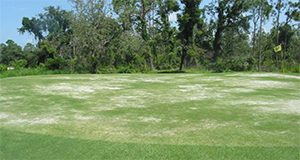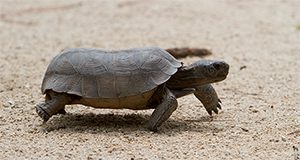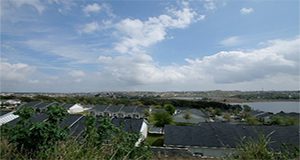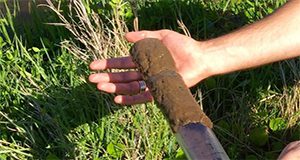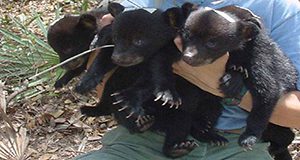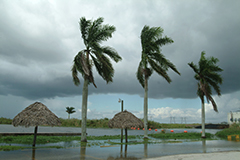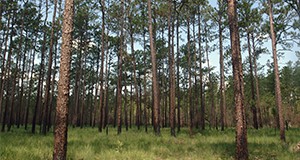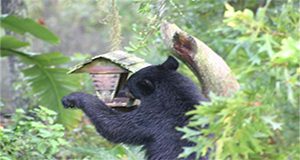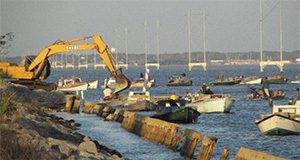While the Florida peach industry is small, it has experienced significant growth in recent years. This 20-page article written by Ariel Singerman, Marina Burani-Arouca, and Mercy Olmstead and published by the Food and Resource Economics Department summarizes the establishment and production costs as well as the potential profitability of a peach orchard in Florida. It includes an enterprise budget, estimates of potential revenue and undiscounted cash flows for different combinations of prices and yields, and an investment analysis. The information in this article should be relevant to both current and potential Florida peach growers.
http://edis.ifas.ufl.edu/fe1016
Author: Susan Gildersleeve
Managing Whiteflies on Landscape Ornamentals
Whiteflies are a common pest of many ornamental plants throughout Florida and the world. There are more than 1,500 species worldwide and over 75 reported in Florida. Although infestation does not always require treatment, it is important to be able to identify and monitor for these pests for effective integrated pest management. This 8-page fact sheet written by Eileen A. Buss, Catharine Mannion, Lance Osborne, and Adam Dale and published by the Entomology and Nematology Department describes whitefly species, their identification and biology, the damage they cause, and best management practices to control them and still maintain healthy populations of natural enemies and other beneficial insects.
http://edis.ifas.ufl.edu/mg254
Whitefly (Bemisia tabaci) Management Program for Ornamental Plants
Silverleaf whitefly is one of the most notorious invasive arthropods worldwide. It feeds on more than 900 plant species and vectors over 100 plant-damaging viruses. This 10-page fact sheet written by Vivek Kumar, Cristi Palmer, Cindy L. McKenzie, and Lance Osborne and published by the Department of Entomology and Nematology provides management recommendations, strategies for detection and scouting, and advice about control measures for this pernicious pest.
http://edis.ifas.ufl.edu/in1171
Recreational Harvesting of the Florida Bay Scallop: Citrus County
This publication includes a full-color map identifying access routes to the boat ramps and marinas in Citrus County near Homosassa and Crystal River, plus the latest information on scallops and scalloping, the recommended equipment you will want to bring, and a few tasty recipes for preparing Florida’s best summertime catch. Written by Savanna Barry and published by the Florida Sea Grant College Program.
http://edis.ifas.ufl.edu/sg147
Cost of Production for Fresh Grapefruit Grown in Indian River, 2015/16
This 4-page article written by Ariel Singerman and published by the Food and Resource Economics Department presents the cost of production per acre for growing fresh grapefruit in the Indian River region during 2015/2016, based on a survey of growers conducted at the Indian River Citrus League production committee meeting in mid-July 2016. The cost estimates do not represent any individual operation; rather, their purpose is to serve as a benchmark for the industry. Typical users of these estimates include growers, consultants, property appraisers, and researchers.
http://edis.ifas.ufl.edu/fe1011
Recreational Harvesting of the Florida Bay Scallop: Steinhatchee and Keaton Beach areas, Taylor County
A full-color map identifying access routes to the boat ramps and marinas in southern Taylor County near Steinhatchee and Keaton Beach, plus the latest information on scallops and scalloping, the recommended equipment you will want to bring, and a few tasty recipes for preparing Florida’s best summertime catch. Written by Victor Blanco and published by the Florida Sea Grant College Program.
http://edis.ifas.ufl.edu/sg146
Recreational Harvest of the Florida Bay Scallop: Hernando County
A full-color map identifying access routes to the boat ramps and marinas in Hernando County, plus the latest information on scallops and scalloping, the recommended equipment you will want to bring, and a few tasty recipes for preparing Florida’s best summertime catch. Written by Brittany Hall-Scharf and published by the Florida Sea Grant College Program.
http://edis.ifas.ufl.edu/sg148
Nematode Management in Residential Lawns
Plant-parasitic nematodes are among the least understood and most difficult pests to manage on turfgrass in Florida. They are very small, and most can only be seen with the aid of a microscope. They use a stylet to puncture plant cells, to inject digestive juices into them, and to ingest plant fluids. The most reliable way to determine whether plant-parasitic nematodes are involved in a turf problem is to have a nematode assay conducted by a professional nematode diagnostic lab. This 6-page fact sheet was written by William T. Crow, and published by the UF Department of Entomology and Nematology.
http://edis.ifas.ufl.edu/ng039
The Value of Private Non-Industrial Forestland for Wildlife Species Conservation
Animals in Florida provide a variety of benefits to people, from recreation (fishing, hunting, or wildlife viewing) to protection of human life and property (oysters and corals provide reef structures that help protect coasts from erosion and flooding). By measuring the economic value of these benefits, we can assign a monetary value to the habitats that sustain these species and assess the value that is lost when development or other human-based activities degrade animal habitat. This 5-page fact sheet written by Shelly Johnson, Timm Kroeger, Josh Horn, Alison E. Adams, and Damian C. Adams and published by the School of Forest Resources and Conservation presents the results of a study that assessed the value of protecting five animal species in Florida and showed the economic value of protecting animal habitat.
http://edis.ifas.ufl.edu/fr405
Collaborative Planning for the Future of Water Resources in Central Florida: Central Florida Water Initiative
Rules and regulations that govern our use of natural resources, specifically water, are changing. Over the past 80 years, Florida’s population increased four times, from approximately 5 million to more than 20 million people. With this population increase, water needs have also increased. Forward-looking communities think about the future of their towns, counties, or the state as they work on redefining regulations to meet future water needs without harming our springs, lakes, rivers, and estuaries. This 4-page fact sheet written by James Fletcher and Tatiana Borisova and published by the Food and Resource Economics Department discusses the Central Florida Water Initiative, which deals with advancing water-use and water-resource-protection strategies for Orlando and its vicinity.
http://edis.ifas.ufl.edu/fe1012
A Beginner's Guide to Water Management—Muck: Causes and Corrective Actions
Muck is both the popular and the scientific term for the material found on the bottom of ponds and lakes. Its “oozy” feel and rotten egg smell can be offensive, and it provides habitat for problem insects like blind midges. It may seem simple: get rid of the muck; get rid of the problems. However, there is more to this muck-raking story. Excessive amounts of muck in the wrong places certainly can cause problems, but just enough muck in the right places is essential for a healthy lake that supports diverse wildlife and fishing. Learn all about muck and what to do about it in this 13-page fact sheet written by Mark V. Hoyer, Daniel E. Canfield Jr. and Mark Brenner and published by the School of Forest Resources and Conservation Program in Fisheries and Aquatic Sciences.
edis.ifas.ufl.edu/fa200
Reducing Human-Bear Conflicts: Bear-Resistant Trash Cans
The Florida black bear (Ursus americanus floridanus) is the only species of bear in Florida, with an estimated population of approximately 4,030 bears. Bears that eat garbage put themselves in danger. This 3-page fact sheet written by Ethan T. Noel, Elizabeth F. Pienaar, and and Mike Orlando and published by the Wildlife Ecology and Conservation Department explains how to secure human garbage from bears so that they don’t become reliant on human food sources, a condition that puts them at great risk of being killed from vehicle collisions, illegal shooting, or euthanasia.
http://edis.ifas.ufl.edu/uw429
Risk Perception and Needs: Defining Extension's Climate Change Adaptation Role
Third in a series on climate change communication for Extension professionals, this 7-page fact sheet written by Mark Megalos, Martha C. Monroe, and Claire Needham Bode and published in April 2017 by the UF School of Forest Resources and Conservation provides strategies for overcoming challenges in communicating about climate change.
http://edis.ifas.ufl.edu/fr403
Timber Production in a Working Forest Context
Working forests are private forests managed not just for timber production but also for a host of valuable ecosystem services like providing for recreation, maintaining habitat for wildlife, and maintaining a healthy watershed. Timber production is an essential ecosystem good or service that supports a number of important industries and provides jobs in Florida. This 6-page fact sheet summarizes the results of several studies to help forest landowners and other stakeholders understand how multiple-use management affects both timber production and other ecosystem services.
http://edis.ifas.ufl.edu/fr406
Nematode Management on Athletic Fields
Turfgrasses are essential components of many athletic fields, racetracks, and parks. Plant-parasitic nematodes can damage athletic fields by weakening turf root systems and causing turf to pull up during play, which can create dangerous conditions for players. To help keep turf–and athletes–healthy, this 7-page fact sheet written by William T. Crow and published by the Department of Entomology and Nematology explains how to spot and manage a nematode problem in an athletic field.
edis.ifas.ufl.edu/in126
Securing Bird Feeders from Florida Black Bears
The Florida black bear (Ursus americanus floridanus) is the only species of bear in Florida, with an estimated population of approximately 4,030 bears. Bears are excellent climbers and can access bird feeders that are suspended from trees. This 3-page fact sheet written by Ethan T. Noel and Elizabeth F. Pienaar and published by the Wildlife Ecology and Conservation Department explains how to secure bird seed from bears so that they don’t become reliant on human food sources, a condition that puts them at greater risk of being killed from vehicle collisions, illegal shooting, or euthanasia.
http://edis.ifas.ufl.edu/uw430
Oysters for the Future: Proper Oyster Culling Techniques Matter
The eastern oyster (Crassostrea virginica) provides many important functions in coastal environments, from serving a crucial role in the estuary’s food web to improving water quality for beachgoers and wildlife. Oysters are also a popular food choice for people. At times the commercial industry landings value has topped $8 million annually in Florida. This 2-page facts sheet written by Erik Lovestrand and published by the Florida Sea Grant College Program is one in a series that highlights some of the key ecological and human factors important to the long-term sustainability of this valuable fishery.
http://edis.ifas.ufl.edu/sg143
Oysters for the Future: Oystering Rules, The Whys and Wherefores
The eastern oyster (Crassostrea virginica) provides many important functions in coastal environments, from serving a crucial role in the estuary’s food web to improving water quality for beachgoers and wildlife. Oysters are also a popular food choice for people. At times the commercial industry landings value has topped $8 million annually in Florida. This 2-page fact sheet written by Erik Lovestrand and published by the Florida Sea Grant College Program is one in a series that highlights some of the key ecological and human factors important to the long-term sustainability of this valuable fishery.
http://edis.ifas.ufl.edu/sg144
Oysters for the Future: The Value of Science-Based Management in the Oyster Fishery
The eastern oyster (Crassostrea virginica) provides many important functions in coastal environments, from serving a crucial role in the estuary’s food web to improving water quality for beachgoers and wildlife. Oysters are also a popular food choice for people. At times the commercial industry landings value has topped $8 million annually in Florida. This 2-page fact sheet written by Erik Lovestrand and published by the Florida Sea Grant College Program is one in a series that highlights some of the key ecological and human factors important to the long-term sustainability of this valuable fishery.
http://edis.ifas.ufl.edu/sg145
Awareness, Knowledge, and Perceptions of Barotrauma and Barotrauma Mitigation: A Survey of Florida Anglers
Saltwater recreational fishing is an important economic engine for Florida’s coastal communities. The annual economic impact to the Florida economy of saltwater recreational fishing, which sustains 110,000 jobs, is estimated to be $13 billion. Given the popularity and economic importance of reef fish, careful management of these fish stocks is imperative for the sustainability of the reef-fish resource. Barotrauma, a phenomenon that causes problems for deep-water fish caught and brought to the surface, is recognized by fishery managers as a key cause of death in “catch-and-release” reef fish. This 5-page fact sheet written by Charles Adams, Joy Hazell, Lisa Krimsky, Bryan Fluech, Betty Staugler, John Stevely, and Robert Botta and published by Food and Resource Economics Department describes a recent survey of Florida saltwater anglers and sheds light on incentives for and constraints against the use of barotrauma mitigation devices.
http://edis.ifas.ufl.edu/fe1010
